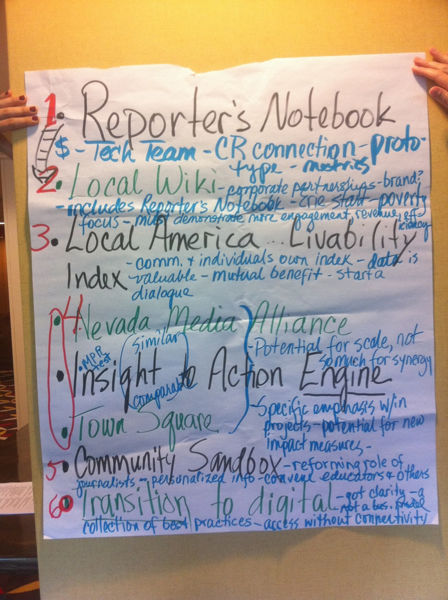Pivot Point: Next steps

Last month, the Reynolds Journalism Institute convened 34 engineers, publishers, editors, researchers and academics in Chicago for a gathering entitled: “Pivot Point: Reinventing Community, Reinventing News in a Connected World.”
In this post, we’ll report on why we gathered, what we did, and what should happen next. We’d like your suggestions. Please email densmorew@rjionline.org, or add a comment to this blog post.
The impetus began with this stark situation assessment in our convening documents:
The U.S. news industry is at a pivot point. It can stay the same as innovators gradually pick off pieces and do them better, faster and cheaper. Or it can declare a new goal to be the most-trusted friend, informant, advisor, agent, steward and broker to people now awash in abundant information — but too little knowledge. Key media system changes already underway include: (1) Content both converging in new forms and breaking into smaller “atomized pieces, (2) Advertising becoming a one-to-one marketing conversation and (3) A publisher shift from information-access gatekeeper to guide, curator or “infovalet.”
The idea was to clearly formulate the challenge, then to expose and perhaps champion some first-step solutions. Next step: Articulating a research-academic-industry collaboration aimed at accelerating the transition to digital.
Mike Fancher, a Donald W. Reynolds Fellow in 2008-2009 and retired executive editor of The Seattle Times, picked up on the “pivot point” theme is a recent email, quoting from author Eric Ries’ The Lean Startup. Reis, says Fancher, defines a business pivot as “a structured course correction designed to test a fundamental hypothesis about the product, strategy and engine of growth.” Reis adds: ““There is no bigger destroyer of creative potential than the misguided decision to persevere. Companies that cannot bring themselves to pivot to a new direction on the basis of feedback from the marketplace can get stuck in the land of the living dead, neither growing enough nor dying, consuming resources and commitment from employees and other stakeholders but not moving ahead.”
If you believe news organizations – particularly newspapers – are at a pivot point – unable to effectively persevere on their current course – then what needs to happen next?
At Pivot Point, we resolved to define and assemble some building blocks for news and information that matters to 21st-century communities. We asked: “How can we provide leadership to both sustain the best of the past, yet build for the future? Is it writing, meetings, behind-the-scenes work, and partnerships? What’s the effective strategy?” Informed by pre-convening phone discussions with our on-site participants, we focused on communities — and how news organizations serve them — as the building block for a new news ecosystem. We proposed, explored or fleshed out at least eight related project ideas.
RJI’s self assignment is to help move to action several of those ideas. That ongoing effort will involve highlighting examples of elements in the emerging news and information ecosystem and stimulating collaboration and additional ideas, experiments and solutions.
1. Identifying, assessing the challenges
Let’s identify the challenges news organizations face. Then we’ll assess about how each of the eight Pivot Point projects might help.
Early in April, we exchanged email with an innovative thinker in the American news ecosystem – a veteran technologist committed to the task of sustaining the values, principles and purposes of journalism. He said: “Getting past the cost control, declining revenue mindset to aggressive action and audience-building investment is and will continue to be a real challenge.” Another thought leader, Rich Boehne, the president and CEO of E.W. Scripps Co., said: “I hope we find ways to work together at much more scale, but it just has not happened to date.”
The last week in April was RJI’s annual “Innovation Week.” It was a chance to ask probing questions about the future of news, and the news industry, informed by some of the unique experiments, research and scholarship RJI has underway. In one session headed by Fancher, it was sobering to hear Tom Rosenstiel of the Pew Project for Excellence in Journalism (PEJ) declare that for the news industry: “The future may not be in advertising.” He added: “We are in the creating knowledge business, not [necessarily] the business of writing narratives and selling ads.” Another Reynolds Fellow, former Tampa Tribune Executive Editor Janet Coats, added in that same session: “It is all about relationships.” Rosenstiel said news organization competitors like Google and Facebook are developing intimate, personal knowledge about the information habits of people in newspaper’s communities.
So the industry needs to:
- Work better together
- Develop revenue beyond advertising
- Forge deeper relationships with users
Last August, this writer authored for RJI, “From Paper to Persona: Sustaining Journalism in the Attention Age.” It recommended formation of a non-profit collaborative to share technology, users and content and concluded this could help news organizations to find new revenues and become better at serving the public.
And Pivot Point participant Henry W. (“Buzz”) Wurzer, a former Hearst Corp. and Tribune Company senior strategy and advertising executive developed his own set of 10 pivot points for the industry that he’s shared with RJI. It’s entitled: “Reinvesting in Story Telling – A Path to New Revenue.” It suggests story telling – whether in narrative or other forms – remains critical to sustaining news gathering.
2. How might the eight projects each help?
We explored eight projects at Pivot Point. Here’s a sense of the challenge each attempts to meet, and how. You can view summaries and more detail on most the projects here.
- Reporters Notebook – If journalists have become disengaged from their readers, viewers and listeners, reporter-turned-technologist Luke Stangel has a fix. He proposes to re-engineer the way newsrooms gather the news – through technology that invites direct public engagement at every step in the process. This should help news organizations to stay close to the needs and interests of the citizens they serve.
- Local Wiki – One of the most common complaints young adults have about conventional news presentation is that stories have too little context or background, so its difficult to understand why they should be considered important. Ex-publisher Martin Langeveld proposes to give local news organization a tool to easily create a dynamic, online linkable encyclopedias of local knowledge focused on community issues, concerns, events and needs.
- Local America – faced with complex financial and organizational challenges, American communities are unsure how to measure success. Former editor Tom Grubisich is working on a platform for communities to define civic needs, then measure and guide progress toward meeting them using a 20-category “Liveability Index” that uses dynamic citizen input.
- Project Nevada Media – As governments, civic organizations, groups and clubs gain the tools to reach their constituencies directly, legacy media organizations are seeking better ways to engage and shape the way new and old media services connect. In Reno, Nevada, journalism dean Al Stavitsky is helping to prototype methods to make this evolving system better and better at meeting community information needs.
- Insight to Action – To counter information overload, technologist Brad Degraf is working with American Public Media and others on an integrated system for auto-curating social media (Twitter, Google+, Facebook) to provide topical and local expert knowledge that provides insight and sparks action.
- Community Sandbox – Participation in important civic decisions is a goal of democracy. To make that possible, local media executive Chuck Peters proposes to integrate a series of initiatives – including elements of several other Pivot Point projects – to assemble what he calls “an asynchronous, demand-driven town hall” for Cedar Rapids, Iowa that gives citizens two-way, web- and mobile-based access to civic decision making.
- Transition Digital – It’s been called the “digital divide” – a lack of access to electronic information that splits along economic lines. To fix the problem startup entrepreneur Matt Galligan proposes initiatives that allow news to be delivered with access to a personal device. Envision the 21st century newsbox as tablet kiosks in public spaces like libraries and cafes.
- The New Network – News and information increasingly reaches us from multiple sources – some local, most national or even worldwide. Buzz Wurzer thinks it’s time to network the two together in a shared-user network for trust, identity, privacy and information commerce. The result, he writes, may be a new way to sustain news gathering through network financial exchange.
So, 34 people and eight ideas. In no way do we hold these up as the collective answer to the future and sustainability of news. The point was simply to try a process of selecting ideas and providing for them some focus and movement. We’ll continue to attempt to do this at RJI, because the need to reinvent journalism’s relationship with the public is urgent.
3. Moving beyond tension, to a new trusted relationship
In a March 5, 2012 report for the Pew Research Center’s Project for Excellence in Journalism, “The Search for a New Business Model,” Tom Rosenstiel and Mark Jurkowitz reported on detailed, on-site interviews with more than a dozen U.S. newspaper ownership groups and gathered proprietary digital revenue data from about 40 newspapers. Beyond all the data, which detailed the immense revenue challenges facing the industry, Rosenstiel said the most important thing they found mostly on the business side of papers was “a still seething tension internally between those pushing for a more digital future and, for want of a better word, people still steeped in a legacy culture.”
In their report, they anonymously quoted one industry executive:
The big issue . . . is who gets the right to deliver the time- and location-sensitive message. It won’t be everybody that gets the right to come into my pocket and beep me because I just walked into the mall . . . So how do we, as the newspaper in town, do what we need to do now to make sure a year or two years down the road, we are the ones with permission and a trusted relationship with the consumer?
We believe RJI is obligated to help mediate that seething tension and reinvigorate a trusted relationship with citizens. The ideas emerging before and during Pivot Point Chicago are among ideas we hope to help shape and test toward that end. What other ideas should we be finding, exploring and championing?
Related Links:

Comments